Search the Special Collections and Archives Portal
Search Results
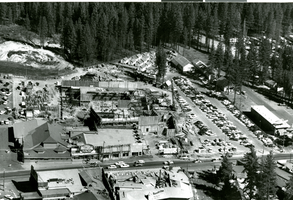
Aerial photograph of Harrah's Stateline Country Club under construction, circa 1958
Date
Archival Collection
Description
Aerial View of Harrah's Stateline Country Club under construction. The country club would later become Harrah's Tahoe.
Site Name: Harrah's Tahoe
Address: 15 Highway 50
Image
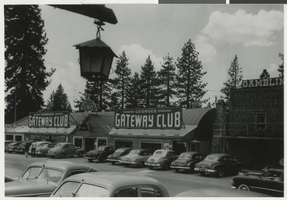
Photograph of Georges Gateway Club (Stateline, Nev.), circa late 1940s
Date
Archival Collection
Description
The Gateway Club at the Nevada state line. Handwritten text on back of photo: "Lake Tahoe #471, Stateline- Gateway Club." Stamp on back of photo: "Credit must be given to the Nevada Historical Society." The Gateway Club became part of Harrah's Lake Tahoe.
Site Name: Harrah's Tahoe
Address: 15 Highway 50
Image
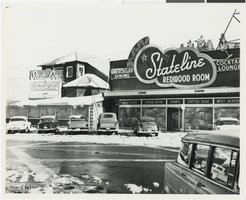
Photograph of the Stateline Redwood Room (Stateline, Nev.), circa early 1950s
Date
Archival Collection
Description
Façade of the Stateline Redwood Room at Lake Tahoe. These buildings were incorporated into Harrah's Tahoe.
Site Name: Harrah's Tahoe
Address: 15 Highway 50
Image
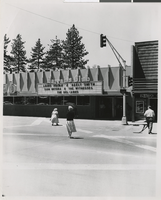
Photograph of the Harrah's Stateline Club façade (Stateline, Nev.), circa 1955
Date
Archival Collection
Description
Façade of Harrah's Stateline Club near Lake Tahoe on Highway 50. Louis Prima and Keely Smith headline. Harrah's Stateline Club became part of Harrah's Tahoe.
Site Name: Harrah's Tahoe
Address: 15 Highway 50
Image
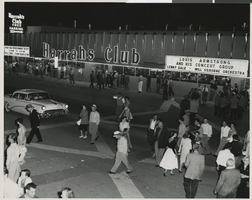
Photograph of Harrah's Stateline Club façade and marquee (Stateline, Nev.), circa 1955
Date
Archival Collection
Description
Harrah's Stateline Club on Highway 50 with pedestrians and cars. Louis Armstrong with his concert group headlines. Harrah's Stateline Club became part of Harrah's Tahoe. Stamp on back of photo: "Camera Associates, 828 So. Wells Ave., Reno, Nevada."
Site Name: Harrah's Club
Address: 15 Highway 50
Image
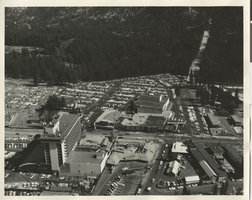
Aerial photograph of Harrah's Tahoe and Harrah's Stateline Club (Stateline, Nev.), 1961
Date
Archival Collection
Description
Aerial view of Harrah's Stateline Club adjacent to Harvey's Tahoe (lower left of photo) and Harrah's Tahoe (center of photo) on either side of Highway 50. Handwritten on original: "Air view 1961."
Site Name: Harrah's Tahoe
Address: 15 Highway 50
Image
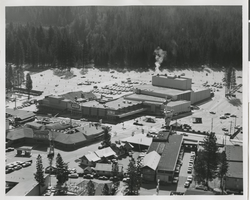
Aerial photograph of Harrah's Tahoe from the southwest (Stateline, Nev.), circa 1960
Date
Archival Collection
Description
Aerial view of Harrah's Tahoe from the southwest.
Site Name: Harrah's Tahoe
Address: 15 Highway 50
Image
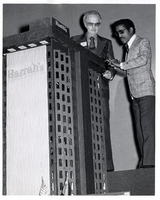
Photograph of Bill Harrah and Sammy Davis, Jr. looking at a model of the Harrah's Tahoe tower, circa 1972
Date
Archival Collection
Description
Bill Harrah and Sammy Davis, Jr. looking at a model of the Harrah's Tahoe Tower.
Site Name: Harrah's Tahoe
Address: 15 Highway 50
Image
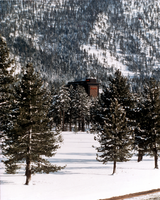
Photograph of Harrah's Tahoe tower from the west (Stateline, Nev.), after 1973
Date
Archival Collection
Description
Winter view of the Harrah's Lake Tahoe tower from the west.
Site Name: Harrah's Tahoe
Address: 15 Highway 50
Image
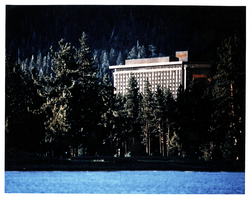
Photograph of Harrah's Tahoe from Lake Tahoe (Stateline, Nev.), after 1973
Date
Archival Collection
Description
View of Harrah's Lake Tahoe from Lake Tahoe. Transcribed from photo sleeve: "Color photo of Harrah's Lake Tahoe."
Site Name: Harrah's Tahoe
Address: 15 Highway 50
Image
